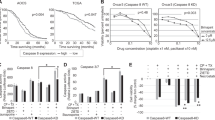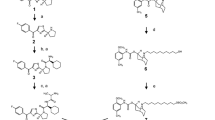Abstract
Interference with the innate apoptotic activity is a hallmark of neoplastic transformation and tumor formation. In this study we characterize the cytotoxic effect of phenoxodiol, a synthetic anticancer drug analog of genestein, and demonstrate the mechanism of action by which phenoxodiol affects the components of the Fas apoptotic pathway on ovarian cancer cells. Primary ovarian cancer cells, isolated from ascitic fluids of ovarian cancer patients, resistant to conventional chemotherapy, undergo apoptosis following phenoxodiol treatment. This effect is dependent upon the activation of the caspase system, inhibiting XIAP, an inhibitor of apoptosis, and disrupting FLICE inhibitory protein (FLIP) expression through the Akt signal transduction pathway. We suggest that phenoxodiol is an efficient inducer of cell death in ovarian cancer cells and sensitizes the cancer cells to Fas-mediated apoptosis. We identified FLIP and XIAP signalling pathways as key factors regulating the survival of ovarian cancer cells. These findings demonstrate a novel nontoxic drug that controls FLIP/XIAP function and has the potential to eliminate tumor cells through Fas-mediated apoptosis.
This is a preview of subscription content, access via your institution
Access options
Subscribe to this journal
Receive 50 print issues and online access
$259.00 per year
only $5.18 per issue
Buy this article
- Purchase on Springer Link
- Instant access to full article PDF
Prices may be subject to local taxes which are calculated during checkout





Similar content being viewed by others
References
Aschkenazi S, Straszewski S, Verwer KM, Foellmer H, Rutherford T and Mor G . (2002). Biol. Reprod., 66, 1853–1861.
Baldwin RL, Tran H and Karlan BY . (1999). Gynecol. Oncol., 74, 265–271.
Berchuck A, Elbendary A, Havrilesky L, Rodriguez GC and Bast Jr RC . (1994). J. Soc. Gynecol. Invest., 1, 181–190.
Constantinou A and Husband A . (2002). Anticancer Res., 22, 2581–2585.
Deveraux QL, Leo E, Stennicke HR, Welsh K, Salvesen GS and Reed JC . (1999). EMBO J., 18, 5242–5251.
Deveraux QL, Roy N, Stennicke HR, Van Arsdale T, Zhou Q, Srinivasula SM, Alnemri ES, Salvesen GS and Reed JC . (1998). EMBO J., 17, 2215–2223.
Flick M, Rodov S, Kamsteeg M, Rutherford T, O'Malley D, Kacinski B and Mor G . (in preparation).
Green DR and Evan GI . (2002). Cancer Cell, 1, 19–30.
Green M, Clark J and Blayroy D . (1984). Semin. Oncol., 11, 209–226.
Gutierrez LS, Eliza M, Niven-Fairchild T, Naftolin F and Mor G . (1999). Breast Cancer Res. Treat., 54, 245–253.
Hanahan D and Weinberg RA . (2000). Cell, 100, 57–70.
Hughes Jr FM and Gorospe WC . (1991). Endocrinology, 129, 2415–2422.
Johnstone RW, Ruefli AA and Lowe SW . (2002). Cell, 108, 153–164.
Kim Y, Suh N, Sporn M and Reed JC . (2002). J. Biol. Chem., 277, 22320–22329.
Kirchhoff S, Muller WW, Krueger A, Schmitz I and Krammer PH . (2000). J. Immunol., 165, 6293–6300.
Krueger A, Schmitz I, Baumann S, Krammer PH and Kirchhoff S . (2001). J. Biol. Chem., 276, 20633–20640.
Lamartiniere CA, Murrill WB, Manzolillo PA, Zhang JX, Barnes S, Zhang X, Wei H and Brown NM . (1998). Proc. Soc. Exp. Biol. Med., 217, 358–364.
Lowe SW and Lin AW . (2000). Carcinogenesis, 21, 485–495.
Mor G, Munoz A, Redlinger Jr R, Silva I, Song J, Lim C and Kohen F . (2001). Am. J. Reprod. Immunol., 46, 298–307.
Mor G, Straszewski S and Kamsteeg M . (2002). Biochem. Pharmacol., 64, 1305–1315.
Mori T, Xu J, Mori E, Sato E, Saito S and Guo M . (1997). Hormone Res., 48, 11–19.
Muller M, Wilder S, Bannasch D, Israeli D, Lehlbach K, Li-Weber M, Friedman SL, Galle PR, Stremmel W, Oren M and Krammer PH . (1998). J. Exp. Med., 188, 2033–2045.
O'Dwyer PJ, Moyer JD, Suffness M, Harrison Jr SD, Cysyk RHTC and Plowman J . (1994). Cancer Res., 54, 724–729.
Panka DJ, Mano T, Suhara T, Walsh K and Mier JW . (2001). J. Biol. Chem., 276, 6893–6896.
Peter ME, Scaffidi C, Medema JP, Kischkel F and Krammer PH . (1999). Results Probl. Cell Differ., 23, 25–63.
Quirk SM, Cowan RG and Huber SH . (1997). Endocrinology, 138, 4558–4566.
Reed JC . (2002). Nat. Rev. Drug. Discov., 1, 111–121.
Rohn JL, Hueber AO, McCarthy NJ, Lyon D, Navarro P, Burgering BM and Evan GI . (1998). Oncogene, 17, 2811–2818.
Roughton SA, Lareu RR, Bittles AH and Dharmarajan AM . (1999). Biol. Reprod., 60, 797–804.
Salvesen GS and Duckett CS . (2002). Nat. Rev. Mol. Cell. Biol., 3, 401–410.
Sapi E, Brown W, Aschkenazi S, Tartaro K, Lim C, Munoz A, Kacinski B, Rutherford T and Mor G . (2002). J. Soc. Gynecol. Invest., 9, 243–250.
Scaffidi C, Schmitz I, Krammer PM and Peter ME . (1999). J. Biol. Chem., 274, 1541–1548.
Soengas MS, Alarcon RM, Yoshida H, Giaccia AJ, Hakem R, Mak TW and Lowe SW . (1999). Science, 284, 156–159.
Soengas MS, Capodieci P, Polsky D, Mora J, Esteller M, Opitz-Araya X, McCombie R, Herman JG, Gerald WL, Lazebnik YA, Cordon-Cardo C and Lowe SW . (2001). Nature, 409, 207–211.
Song J, Rutherford T, Brown S and Mor G . (2002). Mol. Human Reprod., 8, 447–455.
Song J, Sapi E, Brown W, Nilsen J, Tartaro K, Kacinski BM, Craft J, Naftolin F and Mor G . (2000). J. Clin. Invest., 106, 1209–1220.
Song RX, Mor G, Naftolin F, McPherson RA, Song J, Zhang Z, Yue W, Wang J and Santen RJ . (2001). J. Natl. Cancer. Inst., 93, 1714–1723.
Suhara T, Mano T, Oliveira BE and Walsh K . (2001). Circ. Res., 89, 13–19.
Tilly JL . (1996). Rev. Reprod., 1, 162–172.
Tilly JL . (2001). Nat. Rev. Mol. Cell. Biol., 2, 838–848.
Weber G, Shen DF, Li W, Yang H, Look KY, Abonyi M and Prajda N . (2000). Eur. J. Gynaecol. Oncol., 21, 231–236.
Xerri L, Devilard E, Hassoun J, Mawas C and Birg F . (1997). Mol. Pathol., 50, 87–91.
Acknowledgements
We thank Sofya Rodov for technical assistance and Dr Reena Jain from the Department of Pathology for analysis of the cells. This work was supported in part by a grant from the NCI R01-CA92435-01 and NICHD RO1 HD37137-01A2 to GM.
Author information
Authors and Affiliations
Corresponding author
Rights and permissions
About this article
Cite this article
Kamsteeg, M., Rutherford, T., Sapi, E. et al. Phenoxodiol – an isoflavone analog – induces apoptosis in chemoresistant ovarian cancer cells. Oncogene 22, 2611–2620 (2003). https://doi.org/10.1038/sj.onc.1206422
Received:
Revised:
Accepted:
Published:
Issue Date:
DOI: https://doi.org/10.1038/sj.onc.1206422
Keywords
This article is cited by
-
TWIST1 induces proteasomal degradation of β-catenin during the differentiation of ovarian cancer stem-like cells
Scientific Reports (2022)
-
CBX7 binds the E-box to inhibit TWIST-1 function and inhibit tumorigenicity and metastatic potential
Oncogene (2020)
-
Triggering of eryptosis, the suicidal erythrocyte death, by phenoxodiol
Naunyn-Schmiedeberg's Archives of Pharmacology (2019)
-
Adipocyte microenvironment promotes Bclxl expression and confers chemoresistance in ovarian cancer cells
Apoptosis (2017)
-
MicroRNA-155 promotes apoptosis in SKOV3, A2780, and primary cultured ovarian cancer cells
Tumor Biology (2016)



